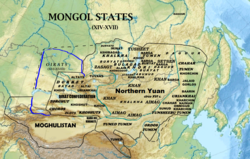Four Oirat
| Alliance of the Four Oirats | ||||||||||||||
| Дөрвөн Ойрд Dorben Oirad |
||||||||||||||
| Confederation | ||||||||||||||
|
||||||||||||||
|
Location of the Four Oirats (Oirat confederation)
|
||||||||||||||
| Capital | Not specified | |||||||||||||
| Languages | Mongolic | |||||||||||||
| Religion |
Shamanism later Buddhism |
|||||||||||||
| Government | Monarchy | |||||||||||||
| Taishi | Mönkhtömör (Möngke-Temür) | |||||||||||||
| Batula | ||||||||||||||
| Togoon (Toghan) | ||||||||||||||
| Esen taishi | ||||||||||||||
| Legislature | Customary rules
|
|||||||||||||
| Historical era | Postclassical to early modern period | |||||||||||||
| • | Möngke-Temür places himself at the head of the Oirats. | before 1399 1399 | ||||||||||||
| • | The Oirats overthrow a Genghisid Khagan. | 1399 | ||||||||||||
| • | Esen Tayishi becomes Emperor of the Mongols. | 1455 | ||||||||||||
| • | Movement of the Torghuds to the Volga. | 1616–17 | ||||||||||||
| • | Establishments of the Dzungar Khanate and the Khoshut Khanate | 1630s | ||||||||||||
| • | Disestablished | 1634 | ||||||||||||
| Area | ||||||||||||||
| • | XIV–XVI | 1,000,000 km² (386,102 sq mi) | ||||||||||||
| • | XVII | 1,600,000 km² (617,763 sq mi) | ||||||||||||
|
||||||||||||||
| Today part of |
|
|||||||||||||
Mongol-Oirat Code
The Four Oirat (Dorben Oirad), also known as the Alliance of the Four Oirat tribes or the Oirat confederation (Oirads; Mongolian: Дөрвөн Ойрад; in the past, also Eleuths), was the confederation of the Oirat tribes, which marked the rise of the Western Mongols in Mongolian history.
Despite the universal currency of the term "Four Oirat" among Eastern Mongols and Oirats and numerous explanations by historians, no consensus has been reached on the identity of the original four tribes. While it is believed that the term Four Oirats refers to the Choros, Torghut, Dorbet and Khoid tribes, there is a theory that the Oirats were not consanguineous units but political-ethnic units, composed of many patrilineages.
The Oirats were one of the forest peoples who lived in west of the Mongols of Genghis Khan. They submitted to Genghis in 1207 and played prominent roles in the history of the Mongol Empire.
After the overthrow of the Yuan dynasty (1271–1368), Möngke-Temür, a high official of the Yuan, had placed himself at the head of the Oirats. When he died, three chieftains, Mahamu (Mahmud), Taiping and Batu-bolad, ruled them. They sent envoys with gifts to the Ming dynasty. In 1409, the Yongle Emperor (r.1402-24) bestowed upon them the title of wang in return. The Oirats began to challenge the Borjigin Emperors in the reign of Elbeg Khan (c.1394-99).
It is curious to find one of the 3 chief was with Muslim name, Mahmud. Before 1640, the Oirats had been wavering between the two faiths, Islam and Buddhism. Both these creeds had supporters among the pagan Oirats.
...
Wikipedia

